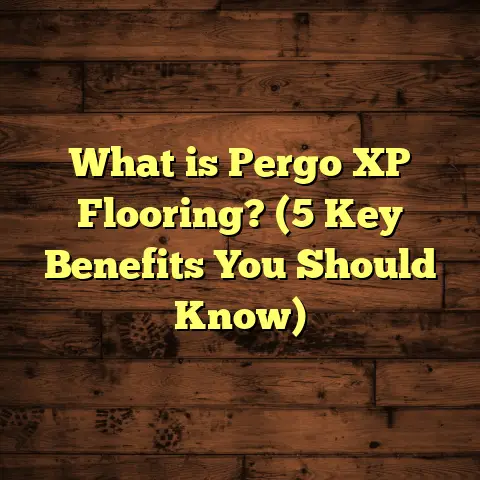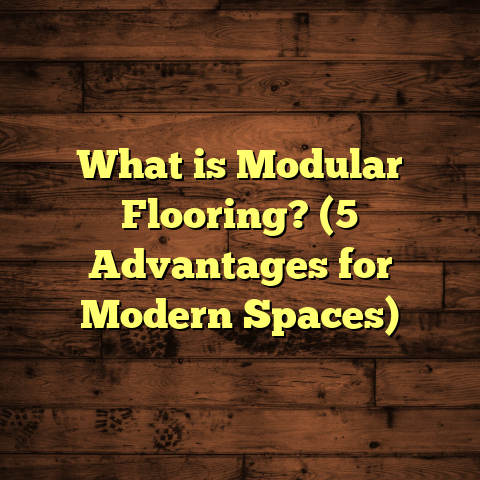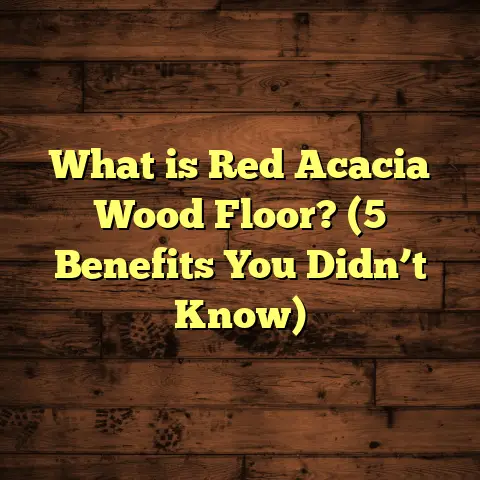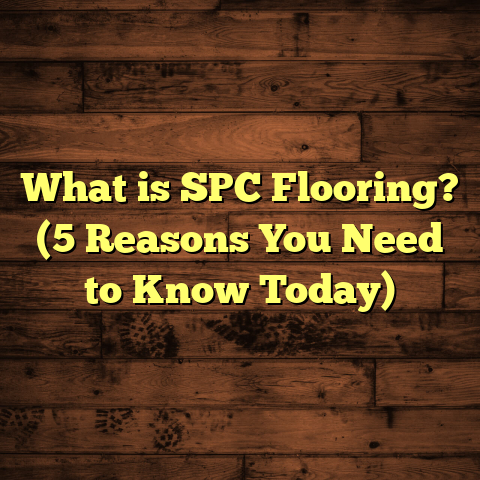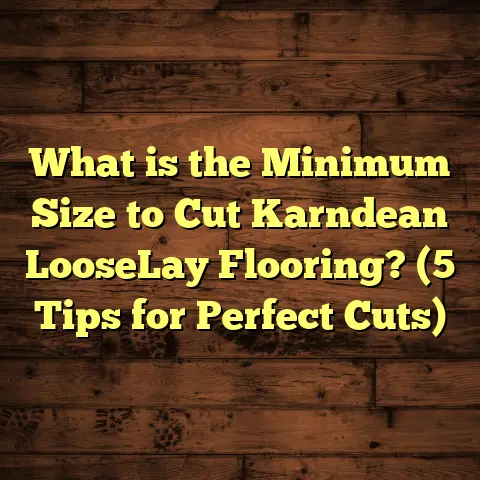What is Bamboo vs Wood Flooring? (5 Key Benefits Revealed!)
Introduction: Matching Flooring to Your Room’s Personality
Ever walked into a room and felt the floor just fit? Like it was made for that space? Over the years, I’ve installed floors in countless homes and commercial spaces—kitchens, living rooms, bedrooms, hallways, even basements—and I keep seeing the same thing: the choice of flooring can totally change how a room feels and functions.
Sometimes a floor is just beautiful to look at. Other times, it’s about durability or how well it handles moisture or heavy foot traffic. And often, it’s a mix of all those things.
For example, a bamboo floor in a sunroom with lots of humidity might work great, but that same floor in a kitchen where water splashes are common could have different results. Or hardwood flooring in a kid’s playroom might bring warmth and elegance but also needs to stand up to scratches and spills.
I always tell friends and clients: the best floor isn’t just the one that looks good in the showroom. It’s the one that fits your lifestyle, your room’s use, and how you want to live day-to-day.
That’s why I want to share everything I know about bamboo and wood flooring—two popular but quite different options. I’ll cover what they are, their benefits, installation tips, maintenance secrets, cost insights, and real stories from my projects. By the end, you’ll have a clear idea of which might be your perfect fit.
What Is Bamboo Flooring vs Wood Flooring?
Bamboo Flooring: Nature’s Fast-Growing Option
Bamboo flooring is made from the bamboo plant—a grass species that grows incredibly fast. Some types can grow up to 3 feet in a day! This speed means bamboo can be harvested every 3 to 5 years, making it one of the most renewable flooring resources out there.
Unlike hardwood trees that take decades or even a century to mature, bamboo regenerates quickly without needing replanting because it grows from root systems underground.
The manufacturing process for bamboo flooring is pretty interesting:
- The bamboo stalks are harvested, then sliced into thin strips.
- These strips get boiled to remove sugars and starches—this prevents mold and bugs.
- After drying, the strips are glued together under heat and pressure to form planks.
- The planks are then sanded smooth and finished with sealants or stains.
This process creates a dense, durable flooring product that resembles wood but has its own unique grain patterns. Bamboo flooring comes mainly in three types:
- Horizontal bamboo: The strips are laid flat side by side showing wider grain patterns with nodes (the joint lines in bamboo stalks). It offers a more rustic look.
- Vertical bamboo: Strips are placed upright so you see narrow grain lines running lengthwise; it looks cleaner and more uniform.
- Strand-woven bamboo: Strips are shredded into fibers and re-compressed under extreme pressure. This produces the hardest and most durable bamboo flooring available. The grain is dense and textured, almost like woven fabric.
Wood Flooring: Classic Hardwood Elegance
Wood flooring comes from hardwood trees—species like oak, maple, cherry, hickory, walnut, and more. These trees take much longer to grow than bamboo—anywhere from 20 to 100 years depending on species.
Hardwood is milled from these trees into planks or strips, then sanded smooth and finished with stains or protective coatings.
Hardwood floors have been a popular choice for centuries because of their timeless beauty and ability to last for generations when cared for properly.
Each wood species has unique qualities:
- Oak: One of the most common hardwoods in North America. It’s durable with a distinctive grain pattern that adds character.
- Maple: Slightly harder than oak with a fine, less pronounced grain. Often chosen for modern or minimalist styles.
- Cherry: Known for its rich reddish-brown color that darkens over time.
- Walnut: Darker wood with a warm tone and moderate hardness.
5 Key Benefits of Bamboo Flooring Compared to Wood
Over time, I’ve installed both bamboo and hardwood floors in many projects. Let me share five reasons why I often recommend bamboo flooring—and why it might be a better fit depending on your situation.
1. Sustainability and Environmental Impact
I’m passionate about eco-friendly building materials because I want my home projects to leave a smaller footprint on the planet. Bamboo really stands out here.
- Bamboo regenerates quickly—harvested every 3 to 5 years compared to hardwood trees taking decades.
- It helps reduce deforestation pressures by providing an alternative to slower-growing timber.
- Bamboo absorbs more carbon dioxide and releases more oxygen than many tree species.
- Many bamboo products come from responsibly managed forests certified by groups like FSC (Forest Stewardship Council).
By switching from traditional hardwood to bamboo flooring in some projects, I’ve seen clients feel good about choosing a material that’s renewable and less taxing on natural resources.
Data point: According to research from the International Network for Bamboo and Rattan (INBAR), bamboo produces 35% more oxygen than an equivalent stand of trees over the same period.
2. Durability and Hardness
You might assume hardwood is tougher just because it’s “real wood,” but strand-woven bamboo can actually be harder than many hardwoods.
The Janka hardness scale measures how resistant wood is to denting and wear:
- Strand-woven bamboo scores around 1,400.
- Red oak (very common hardwood) scores about 1,290.
- Hard maple scores roughly 1,450.
I’ve installed strand-woven bamboo floors in busy cafés and office spaces where foot traffic is intense—and they held up incredibly well over time. In fact, they often outperform engineered hardwood options in similar conditions.
If you have kids or pets who love running around or scratching floors unintentionally, strand-woven bamboo might be your best bet for durability.
3. Moisture Resistance
Moisture is the enemy of almost all wood floors—it causes warping, cupping, and even mold growth if ignored.
Bamboo has a denser fiber structure than many hardwoods which makes it naturally more water-resistant. This doesn’t mean it’s waterproof—no natural wood product is—but it can handle humidity changes better without significant damage.
One project I did involved installing bamboo flooring in a sunroom where humidity levels fluctuated daily with weather changes. After two years, the floor showed minimal expansion or cupping compared to neighboring hardwood floors that exhibited noticeable warping.
If you live in a humid climate or want flooring for spaces like kitchens or basements where moisture exposure is possible, bamboo can be a safer choice.
4. Cost Efficiency
Budget is always a big factor when planning flooring projects. Bamboo often provides excellent value without sacrificing quality or style.
Based on my experience sourcing materials:
- Mid-range bamboo flooring typically costs between $3 and $7 per square foot.
- Hardwood flooring usually ranges from $5 to $10 or more per square foot depending on species and grade.
One tool I rely on heavily is FloorTally—a web-based calculator that helps me estimate total project costs by incorporating local labor rates and material prices automatically. Using this tool saves me hours compared to manual calculations and ensures my budgets are accurate down to the last dollar.
Being able to compare bamboo versus hardwood costs side by side helps clients make confident decisions that fit their budget without surprises later on.
5. Unique Aesthetic Appeal
Bamboo offers a modern yet natural look that stands out from traditional wood floors.
- Horizontal bamboo has a rustic vibe with wider grain patterns.
- Vertical bamboo looks sleek and minimalist with narrow grain lines.
- Strand-woven bamboo presents a textured look that’s almost industrial or contemporary.
I noticed many clients who want “something different” but still natural tend to go for bamboo because it adds character without feeling too conventional.
It also comes in various finishes—from light natural blondes to rich carbonized darker tones—offering flexibility no matter your décor style.
Installation Insights: Bamboo vs Wood
Maybe you’re thinking about doing the installation yourself or hiring pros. Either way, here’s what I’ve learned from tons of hands-on experience on job sites.
Subfloor Preparation: Critical Step for Both
Both bamboo and hardwood require a clean, dry subfloor before installation.
- Plywood or concrete subfloors need leveling and moisture barriers where required.
- Bamboo tends to be less forgiving if moisture remains trapped underneath—especially solid bamboo floors—so using vapor barriers is crucial in damp areas like basements.
- Hardwood also needs dry subfloors but may tolerate small variations better depending on species and thickness.
Installation Methods: Variety Depending on Product
There are three main installation methods I see used:
- Nail down: Common for solid hardwood installed on wooden subfloors.
- Glue down: Used for both bamboo and hardwood on concrete or plywood; requires strong adhesives.
- Floating floors: Popular for engineered wood and some bamboo products with click-lock designs; planks “float” over an underlayment without being nailed or glued down.
Bamboo flooring comes as:
- Solid planks (similar thickness as hardwood)
- Engineered planks (bamboo veneer over plywood layers)
Engineered bamboo offers more stability when humidity fluctuates because plywood layers resist expansion better than solid wood alone.
Time and Skill Required: What You Should Expect
From personal projects I’ve managed:
- Hardwood nail-down takes longer because every plank needs precise nailing and alignment.
- Bamboo floating floors can go faster thanks to easy click-lock systems that don’t require glue or nails.
However, because bamboo’s hardness is greater than many woods, cutting it cleanly requires diamond-tipped saw blades or carbide tools; otherwise edges can splinter or tear out during cuts.
If you’re planning DIY installation, make sure your tools match the material hardness!
Maintenance Tips: Keeping Floors Beautiful Long-Term
Years after installing floors, clients often call me asking how to keep their investment looking fresh. Here’s what works best from my experience:
For Bamboo Floors
- Clean spills right away to avoid stains.
- Use soft brooms or microfiber mops; avoid harsh scrubbing tools.
- Stick with manufacturer-recommended finishes or sealants; refinishing may be possible but less common than hardwood.
- Don’t flood with water during cleaning; damp mop only.
- Place area rugs at doorways or heavy-use areas to minimize dirt grinding wear.
For Hardwood Floors
- Wipe spills immediately to prevent water damage.
- Sweep regularly to avoid scratches caused by grit or debris.
- Refinish hardwood floors every 7 to 10 years depending on wear patterns.
- Maintain indoor humidity levels around 35%-55% to minimize expansion/contraction cycles that cause gaps or buckling.
Maintaining stable humidity levels indoors benefits all wood-based flooring types by reducing stress caused by moisture changes.
Personal Story: Choosing Flooring for My Own Home
When my family decided to renovate our living room last year, I found myself torn between bamboo and oak hardwood flooring options.
The room gets lots of natural sunlight streaming through big windows plus occasional humidity from our indoor plants. We also run a small home office there—so durability was top priority alongside aesthetics.
After weighing pros and cons (and testing samples extensively), I went with strand-woven bamboo for several reasons:
- It’s tough enough for my kids who love running around barefoot.
- The eco-friendly aspect felt right for our green lifestyle goals.
- The modern grain pattern matched our mid-century style furniture perfectly.
Installation was smooth thanks to floating floor planks with click-lock design. After six months of daily foot traffic plus a few accidental spills (all cleaned promptly), the floor still looks brand new.
This personal experience showed me how bamboo can combine beauty with practicality beautifully when chosen carefully.
Case Study: Commercial Use of Bamboo Flooring
A local café owner contacted me wanting durable flooring capable of handling heavy foot traffic plus occasional coffee spills—but also warm and inviting for customers.
We chose strand-woven bamboo throughout the space due to its toughness plus attractive texture.
After one year:
- Minimal wear despite hundreds of customers walking weekly.
- Easy clean-up after coffee spills; no staining issues.
- Positive customer feedback on floor look & feel.
- Maintenance costs dropped compared to previous vinyl floors which peeled quickly under abuse.
This real-world example highlights how bamboo isn’t just suitable for homes but performs well commercially too.
Flooring Cost Estimation Made Simple with FloorTally
One challenge I often face when planning projects is budgeting accurately. Flooring prices vary widely based on materials, finishes, room size, labor costs—and these factors differ by location.
That’s why I rely on FloorTally whenever I plan installations:
- It lets me enter exact room dimensions.
- Allows selection between different materials including many types of bamboo and wood flooring.
- Pulls local labor rates automatically based on zip codes or regions.
- Includes waste factors (usually 5%-10%) so extra materials are accounted for during cutting mistakes or fitting odd spaces.
Using FloorTally saves me hours compared to manual calculations while giving clients crystal-clear budgets upfront—avoiding surprise costs later on.
This tool helps me offer clients apples-to-apples comparisons between bamboo and hardwood options based on real market prices near them—not just generic price ranges online.
Final Thoughts: Which One Should You Pick?
Let me boil it down simply based on what I encounter most:
| Factor | Bamboo | Wood |
|---|---|---|
| Sustainability | High (fast-growing & renewable) | Moderate (slow growth) |
| Hardness | Extremely hard (especially strand-woven) | Varies widely by species |
| Moisture Resistance | More water-resistant | Susceptible to warping |
| Cost | Generally more affordable | Can be pricey depending on wood |
| Aesthetic Variety | Modern & distinctive | Classic & timeless |
| Installation | Easier as floating option exists | Nail/glue down mostly |
Ask yourself these questions:
- How much traffic will your floor see?
- What’s your budget ceiling?
- How humid or moist will the room get?
- What style fits your home’s look?
Answering these points narrows down your choices fast—and either way proper installation plus routine maintenance will keep your floors looking great for years.
If you want help crunching costs based on local labor/material rates before buying anything—try tools like FloorTally early in your planning process; they make budgeting painless!
Diving Deeper Into Bamboo Flooring Varieties
To get even clearer about which type of bamboo might suit you best, here’s an expanded look at each kind:
Horizontal Bamboo
This type shows wider grain patterns with visible nodes—those little rings along each stalk section where it bends naturally. It provides an organic feel with some texture variation across planks.
I installed horizontal bamboo in an artist’s studio once because they loved the rustic vibe combined with natural warmth underfoot while still being durable enough for paint spills (which cleaned up easily).
Vertical Bamboo
Vertical bamboo features narrow grain lines running lengthwise, creating cleaner lines perfect for minimalist interiors or modern homes.
My sister chose vertical bamboo for her apartment because she wanted something sleek but still warm—plus she appreciated how consistent it looked across large areas without pronounced knots or rings distracting the eye.
Strand-Woven Bamboo
The toughest option made by shredding fibers then compressing them under extreme pressure into dense planks. This type often has a textured surface resembling woven fabric patterns—a unique aesthetic not found in traditional wood floors.
I’ve recommended strand-woven bamboo in busy offices where durability was critical but clients still wanted natural materials rather than carpet tiles or laminates.
Hardwood Species Details Worth Knowing
If you lean toward classic wood floors instead of bamboo, here’s some more info about popular hardwood species:
Oak
Oak remains hugely popular due to its balance between durability and characterful grain patterns. Red oak features warm tones while white oak leans cooler with grayer hues.
It’s tough enough for most homes but can dent if heavy furniture isn’t protected by pads underneath legs.
Maple
Harder than oak with tighter grain patterns; maple suits modern spaces well because of its light color palette. However, it tends to show scratches more visibly compared to oak because of its smooth finish surface.
Cherry
Cherry wood offers rich reddish hues that deepen naturally over time thanks to oxidation when exposed to sunlight—a feature many homeowners adore for its evolving beauty.
It’s softer than oak so better suited in lower traffic rooms like bedrooms or formal living rooms unless protected carefully.
Walnut
Walnut is prized for its dark chocolate tones combined with contrasting lighter sapwood edges within each plank—a real statement wood floor option. It’s moderately hard but expensive compared to other species.
Addressing Common Concerns About Bamboo Flooring
Some people hesitate about bamboo because they worry it won’t last as long as hardwood or that it might be prone to damage. Let me address those directly:
Is Bamboo More Prone to Scratching?
Not really—strand-woven bamboo especially is very hard and scratch-resistant. Solid horizontal/vertical types can scratch easier but still comparable to softer hardwoods like pine or cherry.
Does Bamboo Fade in Sunlight?
Like any natural material exposed to UV rays long term, some color change occurs over time—usually lightening rather than darkening. Using window coverings helps protect floors if direct sunlight hits them daily.
Can Bamboo Flooring Be Refinished?
Solid strand-woven & horizontal/vertical floors can sometimes be sanded & refinished once or twice depending on plank thickness; engineered versions generally cannot be refinished easily due to thin veneers.
What About Off-Gassing From Adhesives?
Low-VOC adhesives are standard now in reputable manufacturers’ products minimizing indoor air quality concerns. If sensitive, check certifications like FloorScore or GREENGUARD when buying flooring materials.
Care Techniques That Extend Life Span
Beyond basic maintenance already mentioned:
- Use felt pads under furniture legs—even heavier items—to prevent dents/scratches.
- Avoid high heels walking directly on floors since pointed pressure can cause dents especially on softer woods.
- Change cleaning cloths often during mopping so dirt isn’t just spread around causing micro scratches over time.
- Try not to drag heavy objects across floors; lift instead when moving furniture/appliances.
Following these simple habits really pays off over time in maintaining floor beauty and structural integrity regardless of whether you choose bamboo or hardwood flooring.
Comparing Environmental Footprints: A Closer Look
I’m asked often about which option is “greener.” Here is what data shows:
| Environmental Factor | Bamboo | Hardwood |
|---|---|---|
| Growth Rate | 3–5 years harvest cycle | 20–100 years growth |
| Carbon Sequestration | High; fast absorption | Moderate |
| Soil Erosion | Minimal (grass root system) | Can be higher due to logging |
| Chemical Treatments | Sometimes used in adhesives | Varies by manufacturer |
| End-of-Life Disposal | Biodegradable | Biodegradable |
While both are natural products biodegrading at end-of-life phases—bamboo’s rapid renewability usually gives it an edge environmentally if sourced responsibly from managed plantations rather than wild harvesting zones prone to deforestation risks.
The Big Picture: Matching Floors With Lifestyle Needs
Ultimately flooring choice boils down not only to price and appearance but how your lifestyle interacts with it:
- Do you have pets who shed hair & scratch floors regularly?
- Are children running around barefoot often?
- Is your home climate humid or dry?
- How much foot traffic does your floor get daily?
For instance:
If you have active kids + pets + moderate humidity levels = strand-woven bamboo might serve best combining toughness + moisture resistance + affordable price point + unique style.
If you want traditional warmth + rich color options + classic appeal + plan refinishing decades down road = pick hardwood species like oak or walnut but prepare budget accordingly including maintenance costs long term.
Wrapping Up My Thoughts Without Wrapping Up!
Choosing between bamboo vs wood flooring can feel overwhelming at first glance because each has distinct advantages depending on what you prioritize most: eco-friendliness? Durability? Style? Budget?
From my hands-on experience installing dozens of floors combined with client feedback over years—I’ve seen both materials shine when matched correctly with room use & lifestyle needs plus installed well!
I encourage you not just to think about looks but how your floors will perform daily through wear & tear plus environmental conditions over time.
And don’t forget tools like FloorTally can make budgeting painless by factoring local labor/material prices so you know exactly what your project will cost before buying anything!
Feel free to reach out anytime if you want installation tips tailored specifically for your project type or care advice based on real-world use cases I’ve managed personally over many years helping homes get floors they love living with every day!
